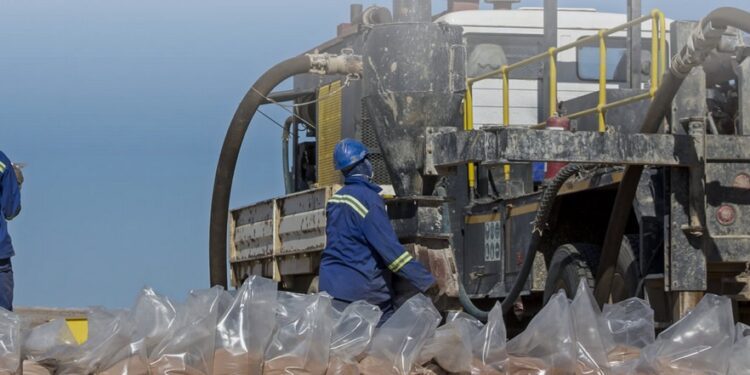Deep Yellow Limited (ASX:DYL) has successfully completed the latest hole in Phase 2 follow-up drilling at the Barking Gecko North prospect (EPL3669) in Namibia.
The Barking Gecko prospect is part of the Nova Joint Venture (NJV) located within EPL 3369 in Namibia. The purpose of drilling diamond hole TN270DDT was to acquire critical core sample material for detailed geological and structural logging to assist with the clarification of the 3D setting of the highly prospective, strongly mineralised zone discovered at Barking Gecko North.
To date, this zone has only been tested by RC drilling. With completion of hole TN270DDT, the mineralised alaskite intrusions can be more accurately studied to develop a better understanding of the mineralisation controls, enabling optimal positioning of the RC holes planned for the next stage of the Phase 2 drill programme.
Phase 1 drilling at Barking Gecko North comprised of 14 holes for 3,561m and was completed in October 2021. Importantly, this programme returned encouraging results, with 13 of the 14 holes intersecting uranium mineralisation. The standout result was from hole TN258RC, which contained 70m at 503ppm eU3O8 within four intersections over an 83m thick zone from 178m depth, as reported on 5 August and 19 October 2021.
Phase 1 NW-SE orientated drilling in the central area delivered the best results. TN270DDT was targeted to undercut this mineralisation and intersect an east-west-trending fault, interpreted from magnetic data, which is considered to influence the setting of the mineralisation.
TN270DDT was angled 70 degrees to the north to obtain orientated core to better define, understand and confirm the structural setting of this mineralisation, which to date, was interpreted from RC drill chips and down-hole optical televiewer (OPTV) surveys.
TN270DDT intersected 118m at 352ppm eU3O8 from 75m using a 100ppm eU3O8 cut-off grade occurring within eight intersections over a 190m interval. This confirms the strong mineralisation associated with this prospect, the northeast-southwest trend of the mineralised intrusions and the presence of an east-west trending fault. The best continuous intersections within the mineralised envelope include 10m at 954ppm eU3O8 from 88m, 60m at 304ppm eU3O8 from 150m and 30m at 382ppm eU3O8 from 235m.
Early inspection of the core indicates a general SW-NE dipping trend of the mineralised intrusions. More detailed work is currently in progress to confirm this trend and to identify the nature of the specific mineralised intrusions and their 3D settings within the general mineralised envelope.
The drilling results continue to confirm the exceptional thickness and grade of previous drilling. The next stage of Phase 2 RC drilling is planned to start 24 January, to further evaluate the possible economic significance of Barking Gecko North.
In-house portable XRF (pXRF) assaying of all mineralisation at Barking Gecko North is in progress. Preliminary results confirm that mineralisation is uranium dominant, with minor thorium associated.
Managing Director/CEO, John Borshoff, said the results from TN270DDT, in conjunction with Phase 1 drilling at Barking Gecko North, remain encouraging, with the prospective nature of this zone being confirmed.
The size of the prospective zone containing high grade and thick uranium mineralisation, as identified to date, appears to be restricted at this stage to 700m by 200m. However, further drilling is required to test the continuation of the mineralisation to the north and south as well as at depth.
The interesting feature of Barking Gecko North is the high-grade character of the mineralisation that is being encountered, which is very similar to what is found at the near-adjacent Rossing and Husab uranium deposits. On this basis alone the follow up drilling that is planned on this target is highly justified
The next stage of Phase 2 drilling will comprise of 10 RC holes for 2,500m and is planned to start 24 January. Results are expected by early/mid-March.
For further information please visit: https://deepyellow.com.au/












